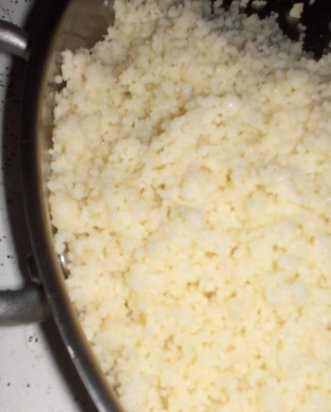
Couscous is a marvelous dish when prepared properly. I don’t mean the kind of couscous you make by soaking it in hot water for ten minutes. I mean the kind of couscous you steam forever, smother in butter, steam forever again, etc. OK, I admit, this type of couscous comes in a box too. (Most of us don’t have the time to painstakingly prepare the tiny pasta from scratch.) But when served with traditionally cooked vegetables and meat, couscous is a pleasure to eat—deeply satisfying and soulful.
Traditionally, couscocus is served on Tuesdays, laundry day in certain North African communities. While waiting for their laundry to dry, North African women would prepare the pasta and dry it in the sun. Thus laundry day became a social event, an opportunity to get together with friends and neighbors to gossip and exchange recipes.
The Tuesday couscous tradition persists in Israel at North African mom and pop eateries. Traditionally, couscous is served with a soup of vegetables and meat, eather chicken or beef. The types of vegetables and the spices used vary depending on the regional extraction of the cook.
The couscous joint I frequented in Israel was run by a family of Tripolitan extraction. Their couscous included carrots, potatoes, turnips, and zucchini, as well as chicken. Effie, the owner, always had a full house on Tuesdays, when all the high tech employees in the neighborhood would converge on his place for a plate of some down home couscous and little complimentary plates of mezze and pita. Effie’s has no menu.
Instead, Effie would greet everyone with a smile and some friendly banter, and proceed to rattle off the specials of the day. He’d then take everyone’s order faster than any waiter I’ve seen before or since, and pass them on to his wife in the kitchen. One of his sons would cover the table with simple sheet of butcher paper, and another son would arrive with plates and cutlery. The first son would return with a basket of fresh, warm pita bread and small mezze plates, including hummus with olive oil, olives, a Tunisian pumpkin spread, and two types of eggplant salad. It was always a challenge to eat all the mezzeh and still have room for couscous.
Couscous veMafroum
(That’s the official name, but everyone calls it Effie’s)
12 Yehezkel Kazaz St.
Or Yehuda, Israel
03-5339252
couscous with vegetables
Here’s my vegetarian version of couscous with vegetables, loosely based on my memories of Effie’s couscous.
for the vegetables:
1 onion, chopped, or 3 shallots, chopped
2 cloves garlic
3 small carrots, peeled
1 large turnip, peeled
1 large potato, peeled
1 cup garbanzo beans, soaked and cooked
1 bunch chard, spinach, or other greens, washed and coarsely chopped
1/2 tsp whole fenugreek
spice mixture: 1/2 tsp each whole fennel and coriander seeds, 2 tsp whole cumin seeds
(If you don’t have whole spices, use pre-ground. Just spice the vegetables a little more cautiously, reserving any leftover spice mixture for a later use. It is best, however, to use whole spices.)
salt to taste
for the couscous:
250 gr coucous
butter
salt to taste
equipment:
couscousiere, or a medium sized pot with a steamer or sieve
(I used a small pot and a vegetable steamer for the couscous, and a separate pot for the vegetables. Ideally, the couscous should steam above the vegetables to as to absorb their flavors.)
- Pour the couscous into a large, shallow bowl and soak in 1/2 cup very cold water for 20 minutes.
- Chop the vegetables into coarse chunks.
- If using whole spices, place in a clean coffee grinder and grind to a powder.
- Heat some butter and olive oil in a pot and add in the onions. Season with salt and stir. You don’t want the onions to turn transluscent without browning.
- Press the garlic cloves into the onions, then add the fenugreek and half the ground spice mixture. Stir to distribute evenly.
- Add chopped vegetables to pot, along with garbanzo beans, and cover with water.
- Drain the couscous and rake it with your fingers.
- Place steamer, sieve, or couscousiere steaming insert above vegetables and place drained couscous in steamer.
- Bring vegetables to the boil, uncovered.
- Keep the vegetables on a low simmer and turn the couscous into a bowl.
- Rake the couscous with your fingers, sprinkle it with 1/4 cup cold water, and season with salt and butter to taste.
- Let stand, and then steam again over the simmering vegetables.
- You can repeat the raking-sprinkling-seasoning-sitting process, as recommended on the Ya Rayi site. I was lazy and hungry, so I steamed the couscous twice, rather than three times. It was still delicious.
Serves 3-4
